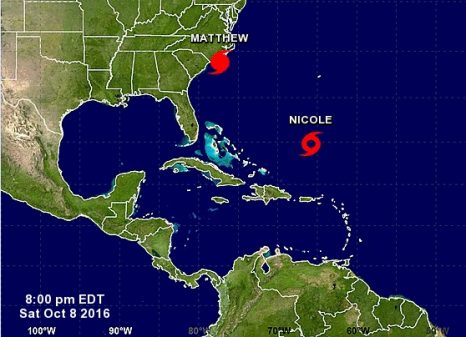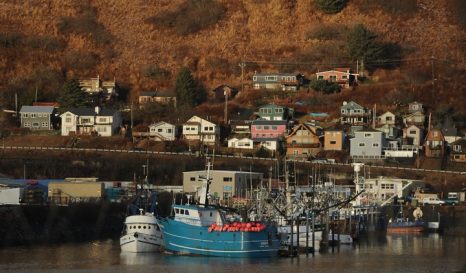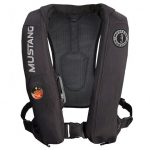Daily Archives: October 8, 2016

Oct 8, 20:00 Hurricane Matthew – Center now east of Cape Fear, record breaking flooding developing over eastern N.C.
At 800 PM EDT (0000 UTC), the center of Hurricane Matthew waslocated near latitude 33.8 North, longitude 77.3 West. Matthew is moving toward the east-northeast near 13 mph (20 km/h), and this motion is expected to continue tonight and early Sunday. On the forecast track, the center of Matthew will be near the coast of southern North Carolina by this evening. Maximum sustained winds remain near 75 mph (120 km/h) with higher gusts. While Matthew is expected to remain near hurricane strength while the center is near the North Carolina coast, the system could become a post-tropical cyclone later tonight or on Sunday. STORM SURGE: The combination of a dangerous storm surge, the tide, and large and destructive waves will cause normally dry areas near the coast to be flooded by rising waters moving inland from the shoreline. The water could reach the following heights above ground if the peak surge occurs at the time of high tide… Murrells Inlet, South Carolina, to Duck, North Carolina, including portions of the Pamlico and Albemarle Sounds…3 to 5 ft Read the update here 20:18
Not Your Average Fish: Tuna Shares ‘Super Predator’ Genes With Great White Sharks
 Despite independent evolution for 400 million years, sharks and tunas still share common genetic traits. They include higher metabolism, body temperature and fast swimming skills. In the lamnid group of sharks, great white sharks are a major presence. Some common genetics make them super predators with brisk swimming power and the ability to stay warm. This was revealed in a new research by Imperial College London which asserted the commonality of genes in the two groups as key to their predatory edge. Regarding the identical genes in both the groups, the team said they are mainly linked with metabolism and the ability to produce energy. The study, published in Genome Biology and Evolution Journal, had Professor Vincent Savolainen from the Department of Life Sciences at Imperial as the Co-author. “Lamnid sharks and tuna both have stiff bodies and tails that allow them to swim in bursts. They can also keep their temperature up in colder waters. Both of these things make them more effective predators, allowing them to snatch prey in usually inhospitable waters,” Savolainen said. Read the rest here 16:41
Despite independent evolution for 400 million years, sharks and tunas still share common genetic traits. They include higher metabolism, body temperature and fast swimming skills. In the lamnid group of sharks, great white sharks are a major presence. Some common genetics make them super predators with brisk swimming power and the ability to stay warm. This was revealed in a new research by Imperial College London which asserted the commonality of genes in the two groups as key to their predatory edge. Regarding the identical genes in both the groups, the team said they are mainly linked with metabolism and the ability to produce energy. The study, published in Genome Biology and Evolution Journal, had Professor Vincent Savolainen from the Department of Life Sciences at Imperial as the Co-author. “Lamnid sharks and tuna both have stiff bodies and tails that allow them to swim in bursts. They can also keep their temperature up in colder waters. Both of these things make them more effective predators, allowing them to snatch prey in usually inhospitable waters,” Savolainen said. Read the rest here 16:41

Coming season cuts and cancellations are causing anxiety for Alaska crabbers
“I’m scared,” said Simeon Swetzof, mayor of St. Paul, a central Bering Sea island with considerable crab dependence. “I don’t know what’s going to happen.” The Alaska Department of Fish and Game closed the 2016-17 Bairdi or tanner crab season on Oct. 5, following a 15 percent cut in the harvest quota for Bristol Bay red king crab and a 50 percent cut in the snow crab fishery. Without intervention from the Alaska Board of Fisheries, requested by tanner crab stakeholders, the millions of pounds and millions of dollars of Bairdi will remain in the sea. Last year, the fishery’s total ex-vessel value was $45.3 million. Crab stocks are managed jointly between the Alaska Department of Fish and Game and the North Pacific Fishery Management Council. The North Pacific council, one of eight councils that manage fisheries from three to 200 miles off the coast, sets the overfishing limits and annual catch limit for crab. ADFG then sets the total allowable catch, or TAC. Tanner crab was one of two stocks the National Oceanic and Atmospheric Administration charted as having a declined biomass. In 2015, the biomass prediction for tanner crab was 163 million pounds. This year, surveys chart a drop down to a biomass of 100 million pounds. Read the story here 12:02
NOAA Launches Observer Safety Program Review
 NOAA is now conducting an Observer Safety Program Review as part of our ongoing efforts to assess and evaluate procedures for keeping U.S. fisheries observers and at-sea monitors safe. The health and safety of our observers and at-sea monitors is a top priority for the agency. The review will focus on seven areas related to safety and health, including: safety reporting, communications, practices and policies, training, regulations, equipment, and international observer programs. An outside contractor will conduct the safety review on behalf of the agency. The work is intense, and conditions can be uncomfortable. Observers may spend days, weeks, or months aboard commercial fishing and receiving vessels. Long trips, close quarters, and their role in monitoring compliance can sometimes lead to tensions onboard. Preparing observers for safe deployments requires an active partnership between NOAA Fisheries (including our Office of Law Enforcement and General Counsel), observers, observer providers, the U.S. Coast Guard, and the fishing industry. Read about it here 10:51
NOAA is now conducting an Observer Safety Program Review as part of our ongoing efforts to assess and evaluate procedures for keeping U.S. fisheries observers and at-sea monitors safe. The health and safety of our observers and at-sea monitors is a top priority for the agency. The review will focus on seven areas related to safety and health, including: safety reporting, communications, practices and policies, training, regulations, equipment, and international observer programs. An outside contractor will conduct the safety review on behalf of the agency. The work is intense, and conditions can be uncomfortable. Observers may spend days, weeks, or months aboard commercial fishing and receiving vessels. Long trips, close quarters, and their role in monitoring compliance can sometimes lead to tensions onboard. Preparing observers for safe deployments requires an active partnership between NOAA Fisheries (including our Office of Law Enforcement and General Counsel), observers, observer providers, the U.S. Coast Guard, and the fishing industry. Read about it here 10:51
Are these Gulf shrimp? Audubon program aims to hook you on local seafood
 “National Seafood Month is very much about educating people about Gulf of Mexico seafood and why it’s important to support Gulf of Mexico seafood,” said John Fallon, assistant director of the GULF program. In New Orleans, the month will be marked with a six-course Tuna Fête on Oct. 25 at Carrollton Market restaurant. The dinner will star Gulf of Mexico yellowfin tuna. Dinner with wine pairings is $150 per person, $100 without wine. Tax and gratuity included. It’s a good time for locals to get in the habit of finding out where the seafood they are eating comes from, he said, noting, “90 percent of seafood consumed in the United States is imported” from other countries. Video, Read the rest here 10:38
“National Seafood Month is very much about educating people about Gulf of Mexico seafood and why it’s important to support Gulf of Mexico seafood,” said John Fallon, assistant director of the GULF program. In New Orleans, the month will be marked with a six-course Tuna Fête on Oct. 25 at Carrollton Market restaurant. The dinner will star Gulf of Mexico yellowfin tuna. Dinner with wine pairings is $150 per person, $100 without wine. Tax and gratuity included. It’s a good time for locals to get in the habit of finding out where the seafood they are eating comes from, he said, noting, “90 percent of seafood consumed in the United States is imported” from other countries. Video, Read the rest here 10:38

Fishy politics lures candidates of every stripe to Kodiak
The lure of reaching a statewide radio audience once again is attracting a full slate of political hopefuls to Kodiak for its popular fisheries debate. On Wednesday, five candidates for U.S. Senate will travel to the nation’s No. 2 fishing port to share their ideas on Alaska’s seafood industry. “It’s a great service to Kodiak, to our fishing communities and to Alaska in general,” said Trevor Brown, director of the Kodiak Chamber of Commerce, host of the event. “Fishing is the state’s largest private-sector employer. I think the candidates realize the importance of the fishing industry.” Since 1990, the Kodiak debates have been an election year staple for candidates running for governor and Congress, and they’ve gotten 100 percent participation. Read the story here 09:41

Oct 8, 0800 Hurricane Matthew – strong winds and dangerous storm serge affecting coast of South Carolina
At 800 AM EDT (1200 UTC), the center of Hurricane Matthew was located by NOAA Doppler weather radars, and an Air Force Reserve Hurricane Hunter aircraft, near latitude 32.5 North, longitude 79.8 West. Matthew is moving toward the northeast near 12 mph (19 km/h), and this general motion is expected to continue today. On the forecast track, the center of Matthew will continue to move near or over the coast of South Carolina today, and be near the coast of southern North Carolina by tonight. Reports from the reconnaissance aircraft indicate that maximum
sustained winds have decreased to near 85 mph (140 km/h) with higher gusts. Although weakening is forecast during the next 48 hours, Matthew is expected to remain a hurricane while the center is near the coasts of South Carolina and North Carolina. Read the update here 08:33
What Hunters and Anglers Should Know Before They Vote
 Americans who enjoy fishing, hunting, and other wilderness sports should be aware of a number of important issues before stepping into the voting booth in November. Despite objections from many prominent Hawaiians and a federal regional fishing council, President Barack Obama recently quadrupled the size of the Papahanaumokuakea Marine National Monument (PMNM), first created by President George W. Bush in 2006. Obama used his executive authority under the Antiquities Act of 1906 to extend the marine reserve’s boundaries, banning fishing and mining in the 200-mile exclusive economic zone surrounding the reserve, which covers much of the northwestern islands of Hawaii and their surrounding waters. Obama’s actions were motivated by a desire to attain as much authority as possible for the federal government and to enhance the power and influence of his radical environmental constituency before leaving office. One of the candidates in the 2016 race, Hillary Clinton, has promised to double down on Obama’s environmental policies. Americans concerned about property rights, hunting, fishing, and states’ rights should make their voices heard about these failed policies. Read the opinion piece here 07:59
Americans who enjoy fishing, hunting, and other wilderness sports should be aware of a number of important issues before stepping into the voting booth in November. Despite objections from many prominent Hawaiians and a federal regional fishing council, President Barack Obama recently quadrupled the size of the Papahanaumokuakea Marine National Monument (PMNM), first created by President George W. Bush in 2006. Obama used his executive authority under the Antiquities Act of 1906 to extend the marine reserve’s boundaries, banning fishing and mining in the 200-mile exclusive economic zone surrounding the reserve, which covers much of the northwestern islands of Hawaii and their surrounding waters. Obama’s actions were motivated by a desire to attain as much authority as possible for the federal government and to enhance the power and influence of his radical environmental constituency before leaving office. One of the candidates in the 2016 race, Hillary Clinton, has promised to double down on Obama’s environmental policies. Americans concerned about property rights, hunting, fishing, and states’ rights should make their voices heard about these failed policies. Read the opinion piece here 07:59












































